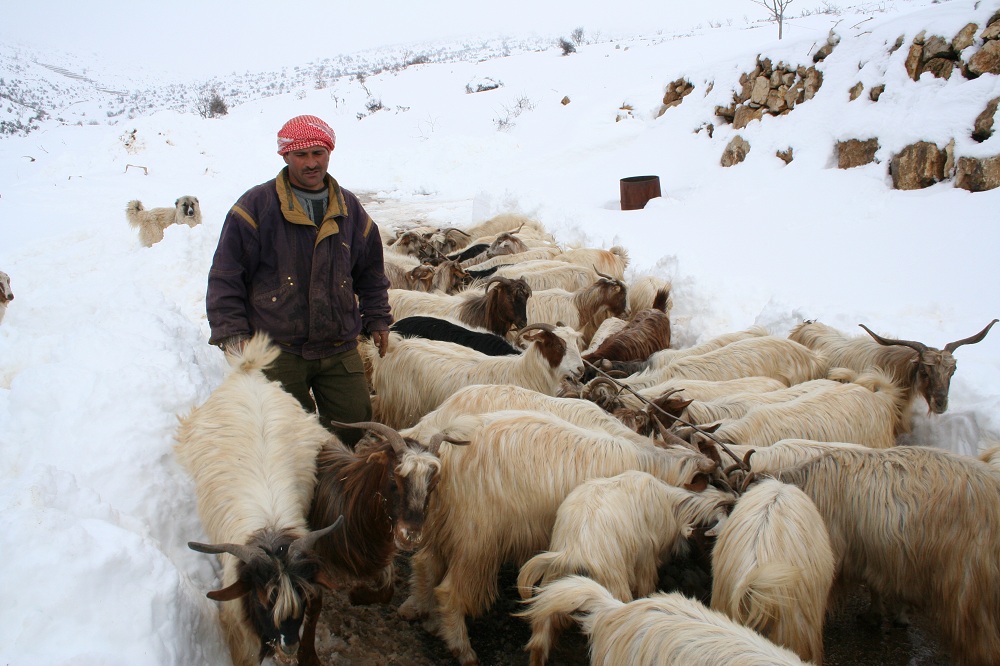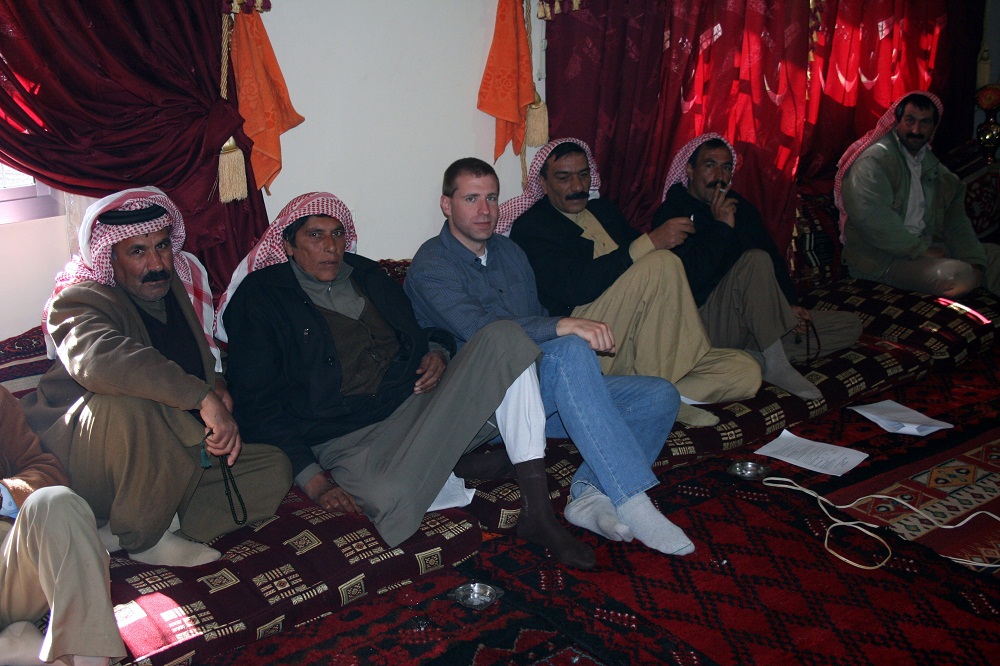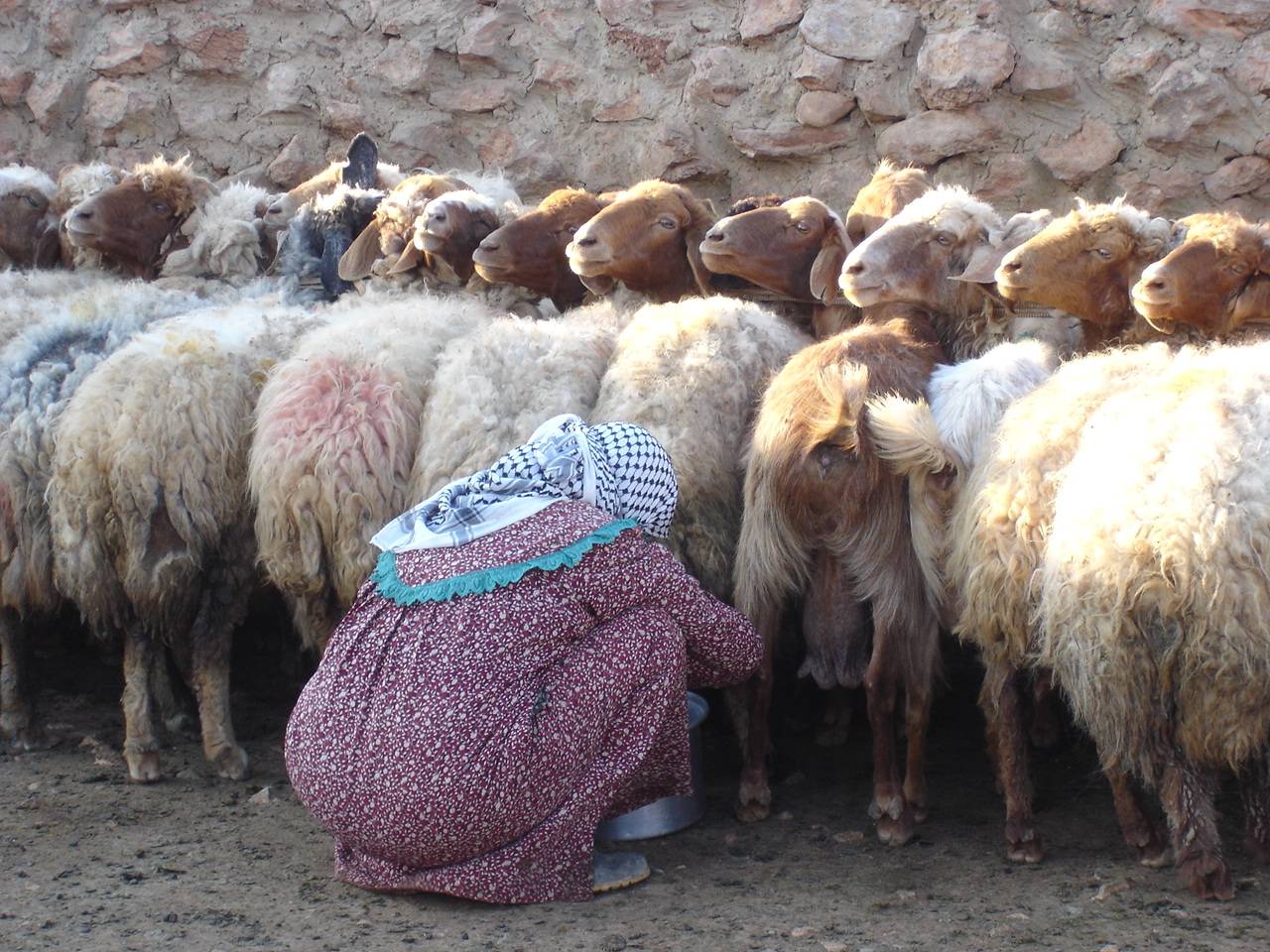Journal of the NACAA
ISSN 2158-9429
Volume 5, Issue 2 - December, 2012
Post-War Extension Education of Small Ruminant Farmers Of The Bekaa Valley, Lebanon
- Smith, J.O, Extension Associate Professor, Utah State University
ABSTRACT
Lebanon is an ancient, Middle Eastern country bordered by the Mediterranean Sea, Israel, and Syria. The Bekaa Valley of Lebanon is mountainous and suited to small ruminant production. The 2006 war between Lebanon and Israel left small ruminant producers of the Bekaa Valley in a difficult economic situation. The United States Agency for International Development (USAID) as part of an aid package to Lebanon, provided technical and financial assistance to livestock producers in the Bekaa Valley. The Bekaa Valley was chosen because this area is a stronghold of the Hezbollah organization and was subsequently heavily bombed by Israel. During the years of 2007 and 2008, the author was recruited by USAID to provide Extension style technical assistance, in partnership with Lebanese agricultural specialists, specifically to small ruminant producers of the Bekaa Valley and southern regions of Lebanon. The major objectives of this assignment were two-fold: (1) to assess weaknesses and strengths related to the small ruminant milk supply chain; and (2) provide hands-on targeted technical assistance basedonthese evaluations, primarily at the producer level, on flock management, animal health, and improved milk production and quality. As result of this assignment over 250 producers received technical assistance on a number of issues in the form of either individual consultations or workshops. Weaknesses in the dairy supply chain such as low milk prices and poor disease management were identified. Castration was also introduced as a tool for managing market sheep and goats.
Introduction
Lebanon is a mountainous country located in the Middle East bordered by Syria, Israel, and the Mediterranean Sea. Mediterranean countries such as Lebanon are characterized by the unique nature of climate and soil. These factors present a great extent of natural spaces where grows a varied pastoral vegetation containing considerable forage varieties for sheep and goats (El-Akram, 2000). Between July 12th and August 14th 2006, large-scale hostilities broke out in southern Lebanon between Lebanon’s Hezbollah and Israel. The Food and Agriculture Organization (FAO) of the United Nations calculated that on the Lebanese side, the conflict resulted in more than 1,187 deaths, 4,398 injuries and large-scale destruction of infrastructure, disruption of essential services and displacement of people (FAO, 2006).
To help revitalize areas of the agriculture industry, specifically small ruminant production, the author was invited to complete two Extension technical assistance assignments in the Bekaa Valley of Lebanon during 2007 and 2008. These assignments were completed under the direction of the United States Agency for International Development (USAID), Agricultural Cooperative Development International(ACDI/VOCA) and Utah State University Extension. The name of the development project was Action for Sustainable Agro-Industry in Lebanon (ASAIL).
In order to further develop the small ruminant sector of Lebanon, the ASAIL project had developed quality clusters (can be defined as cooperatives) in the Bekaa Valley. The Bekaa Valley is home to the majority of Lebanon’s small ruminant industry. ASAIL created four separate clusters with each cluster consisting of a group of approximately twenty producers, a hallab (middleman), and an SME (small to medium enterprise also known as processors). These clusters help benefit a larger group of small ruminant industry producers instead of just various individuals. Each cluster was assigned a coordinator or leader that interacted with an ASAIL representative.
The following issues are the major issues facing the small ruminant industry in the Bekaa Valley. These issues are: milk pricing, animal health, male and market sheep and goat management, milking procedures and mastitis, nutrition and feed costs, record keeping, and barn sanitation.
Assignment Objectives
The objectives for these development assignments were set forth by ASAIL project staff as a result of input from agricultural producers across Lebanon. The war in 2006 had a devastating effect on major agricultural industries particularly the small-ruminant industry.
The objectives expected to be accomplished as a result of these assignments included:
- Assess strengths and weaknesses in the small ruminant dairy supply chain.
- Based on these assessments, provide workshops to dairy cooperatives on how to solve problematic issues.
- Provide hands on Extension style technical assistance to small ruminant farmers in the areas of flock management, nutrition, health, genetic improvement, improved milking procedures, and milk handling.
Methods
The author has extensive experience in providing technical assistance in developing countries. From this experience a set of successful and previously proven methods were utilized in completing this assignment and meeting objectives. The following were methods used in achieving assignment objectives.
Partnerships
Finding and working with a competent, honest, and respected partner in the host country has been a successful method. In Lebanon, a key staff member of the ASAIL project served as this partner. As a result of this partner and his connections, workshops and consultations were able to take place in parts of the Bekaa Valley where normally Americans are not allowed. This trust was an integral part in being able to interview key individuals involved in Lebanon’s milk supply chain. With this valuable partnership, four key hallabs in the Bekaa Valley were visited and interviewed extensively to determine milk transport methods and milk supply chain weaknesses. Furthermore, individual visits and interviews took place with four Small and Medium Sized Enterprises (SME’s or processors) to determine milk supply chain weaknesses.
Cooperative Meetings
Each participant in the small ruminant dairy supply chain (farmers, hallabs, and dairy processors) blamed each other for weaknesses that were occurring within the supply chain. In order to try and solve these issues, farmers, hallabs, and dairy processors were all brought together in one location for the first time to discuss and solve issues.
Educating the Farmer
Traveling to the farmer instead of having the farmer traveling to you has been a successful method implemented by the author. Once individual and group visits were made then specific issues facing small-ruminant farmers and dairy processors were determined. To educate small ruminant producers on alleviating these issues, four educational workshops took place for producers covering the subject areas of milk prices, animal health and vaccination schedules, nutrition, and preparing animals for the meat market, castration techniques for male animals, barn sanitation, and proper milking procedures.

Figure 1: Lebanese goat farmer feeding concentrate feed after a series of educational workshops
Hands-On Demonstrations
The author has found that in previous agricultural development assignments that merely lecturing to the farmer on new techniques does not work in most cases. Hands-on demonstrations where the farmer actually participates in the techniques has proven more successful. That was the case in Lebanon. For example, during the four educational workshops that took place, hands-on demonstrations of castration techniques and proper milking techniques were shown.
Results and Impacts
Long term impacts and results are sometimes difficult to determine for short term development projects. For these two assignments there were a number of easily recognizable impacts as a result of consultations and workshops. Selected results and impacts as a result of these two assignments are as follows:
Small Ruminant Dairy Supply Chain
Table 1 provides a financial breakdown outlining an example of where the money is distributed throughout the small ruminant milk supply chain. Data was obtained from field interviews and from ASAIL staff. Please note this is a generalized breakdown only and is used to describe an average small ruminant dairy supply chain from farmer to processor. Incomes and expenses can vary depending on flock size, amount of milk, and other factors. Goats were used as an example because the majority of producers in the Bekaa raise goats. Sheep are similar with the only real differences being a lower amount of milk produced, shorter milking season, and slightly higher milk prices. Sheep meat is also almost $1.00 per kilogram higher than goat meat.
|
Small Ruminant Dairy Suppliers |
Income Received Annually |
|
Goat farmers (150 head herd average) |
$4,990 |
|
Hallab/Middleman (transporting 3 tons of milk per day) |
$20,340 |
|
Processor (processing 1 ton of milk per day) |
$42,687 |
Table 1: Summary of Average Income Received by Groups within the Small Ruminant Supply Chain
The results show that the farmer is making the least amount of income from this venture. The major weakness found in the small ruminant dairy supply chain was the large gaps in income received by the three major suppliers. The following are some possible strategies for trying to equalize the distribution of income within the milk supply chain and to help increase milk prices for farmers:
ASAIL staff should serve as a mediator to bring clusters together ensuring that the farmers, hallabs, and processors are all present. A fair milk price should be agreed upon between these groups and stay with this price throughout the entire milk season. A contract could be written up and signed between the producers (price they will receive for their milk), hallabs (amount of commission they will take), and processors (amount they will pay for the milk). Currently milk prices fluctuate with the highest prices being paid at the beginning of lactation and then dropping steadily as the milk supply increases during mid-lactation. Paying one fixed price throughout the entire season will ensure all producers are receiving the same price for milk and in the long run farmers will benefit by knowing they will be receiving a fixed amount instead of trying to guess on price fluctuations.
Farmers within a cluster can pool funds and purchase a transport truck and hire a driver by paying a daily, weekly, or monthly salary and deliver milk from their farms and grazing lands directly to the processor. This eliminates the “middleman” and will save producers thousands of dollars each year by not having to pay hallab commission fees. Producers must be willing to unite and work together in a true association or cooperative format for this method to succeed.
A second major weakness in the small ruminant dairy supply chain is a result of the farmer. That weakness is mismanagement of diseases. Diseases are a major issue for small ruminant producers in the Bekaa Valley. From interviews with ASAIL staff, interviews with farmers, and from observations of field visits, the following diseases are causing the majority of problems for sheep and goat producers: Foot and Mouth Disease (FMD), Enterotoxaemia (also known as overeating disease), Salmonellosis, Pasteurellosis, Brucellosis, E-coli, Sheep/Goat Pox, and internal and external parasites. One of the most positive aspects of the ASAIL project is the education of farmers on vaccination programs. Before vaccination programs took place (before 2007) farmers reported mortality rates in kids and lambs as high as 60-70%. Farmers were educated on proper vaccination programs. Once the vaccination programs took place, death rates dropped to only 2-5%, which are below normal herd percentages. Farmers saw this huge success rate and are now convinced to continue vaccination programs in the future. Vaccinating their herds will save each farmer thousands of dollars each year.
Figure 2: Lebanese dairy worker milking Awassi sheep the traditional way, which can introduce bacteria into milk
Extension Educational Workshops and Technical Assistance
As a result of these two assignments over 250 small ruminant producers received technical assistance on subjects including nutrition, breeding, health, grazing, and general flock management from either group workshops or individual consultations. All consultations and workshops took place on farms.
Another important result of these assignments was the introduction of castration techniques for male lambs and kids. This concept had not been introduced to farmers of the Bekaa Valley previously (H. Istaytiyyah, personal communication, March 29, 2007). Castration of male animals not being used for breeding purpose decreases the chance of poor quality males accidentally breeding females. A value of 60% of small ruminant farmers involved in the ASAIL Project adapted this practice after being taught.
Hands-on demonstrations of proper milking techniques were taught to farmers. Lebanese farmers milk their goats and sheep from behind instead of from the side. By milking their animals from behind, contaminants such as feces, urine, dirt, wool, and hair would fall into the milking bucket. This is turn raises bacterial counts in the milk. By milking from the side the majority of this contamination could be avoided. Hallabs were taught how to properly transport milk by avoiding the heat of the day and properly cleaning and sanitizing milk containers.

Figure 3: Author providing technical workshop to a group of Bedouin Sheep and Goat Farmers
Discussion
These assignments allowed political and religious tensions to be forgotten temporarily and allowed farmers of all backgrounds to come together and learn for the benefit of Lebanon’s agriculture future. Many farmers blamed the war with Israel on their current financial problems. The war did contribute to a great loss in the agricultural industry of Lebanon. However, many management problems that contribute to financial problems had been occurring before the war. A major issue facing the small ruminant dairy industry is farmers are leaving the industry to find more lucrative work elsewhere. This is a result of low income received from the sale of milk. Hallabs and processors need to realize that the farmer is their major source of income. Without farmers raising animals to produce milk, the entire dairy supply chain will collapse. Farmers, hallabs, and processors need to come together often in a cooperative manner to discuss and agree on fair milk prices.
Small ruminant farmers in the Bekaa Valley must realize that they have a duty to provide cleanmilk. Also they must utilize improved management techniques that they were taught during these development assignments to improve their productivity and income. Farmers must strive to follow the proven management techniques of vaccination programs, proper nutrition, and clean milking techniques. If these techniques are used, Lebanon can become a major contributor of milk and dairy products across the Middle East.
References
Carter, T., Dunston, L., & Humphreys, A. (2004). Syria & Lebanon. Oakland: Lonely Planet Publications.
El-Akram, Ibrahim Znaidi (2000). Sheep and Goat Organic Meat Production in the Mediterranean Region. International Center for Advanced Mediterranean Agronomic Studies. Tunisia. Retrieved: April 15, 2008 from http://orgprints.org/3078/
Food and Agriculture Organization (FAO) of the United Nations (2006). Lebanon, Damage and Early Recovery Needs Assessment of Agriculture, Fisheries, and Forestry. Retrieved: March 23, 2007 from
http://www.fao.org/newsroom/common/ecg/1000445/en/LebanonDNAMFFinalReportTC.pdf

